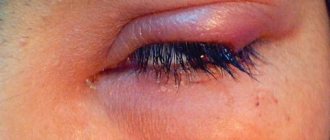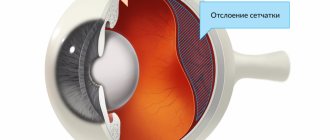Causes of eye pain at high temperatures. Delivery of contact lenses and glasses in Moscow and Russia
Colds and flu are unpleasant illnesses. In addition to the inflammatory process, they are also accompanied by weakness, drowsiness, and high fever. Often with these ailments, a person experiences pain in the eye area. Why do such symptoms appear, what is their cause? We'll tell you in more detail in the article.
Why do my eyes hurt when I have a fever?
With colds or inflammatory diseases - influenza, acute respiratory viral infections and others, accompanied by high fever - the body is greatly weakened.
Our eyeballs have a large number of nerve endings, as well as an extensive network of blood vessels. With an increase in body temperature, a number of negative processes arise in the body, indirectly provoking pain in the eyes.
Here's how experts explain why eyes hurt due to colds and viral diseases:
- Ingress of toxins. Viruses or bacteria, entering the body during illness, begin to release decomposition products. At a temperature, blood flow increases, toxins penetrate more actively into the muscles of the body, which explains the resulting pain and weakness.
- The second reason is sinusitis. With colds, swelling of the nasal mucosa occurs. If the blood vessels are not narrowed in time with medications, severe swelling can close the nasal passages. At the same time, breathing through the nose becomes difficult, and pressure increases in the nasal sinuses. It is its increase that causes pain in the head and eyes during a cold.
We will talk about the causes of eye pain in various diseases that are accompanied by high fever, as well as ways to get rid of unpleasant symptoms.
Why do your eyes hurt when you have a cold?
When you have a cold, pain in the eyes is often caused by severe nasal congestion. In this case, there is redness of the conjunctiva, wings and sinuses, which visibly swell, and profuse lacrimation. There is a constant severe pain in the eyes, it becomes difficult to blink.
The first signs of ARVI are inflammation of the conjunctiva and pain in the eyes. Sinusitis also causes a severe headache, which gets worse when bending over. If ARVI is also accompanied by fever, it also provokes pain, lacrimation, severe burning, and the eyes react to bright light.
Why can your eyes hurt when you have the flu?
Flu is a dangerous inflammatory disease that usually causes a high temperature of 38-39 degrees. In this case, many unpleasant symptoms appear:
- severe headache - it becomes painful even just to move your head;
- pain in the eyes when opening and closing them, as well as from bright light;
- slight decrease in vision clarity.
These symptoms are a consequence of severe intoxication of the body. Influenza occurs as a result of the penetration of a virus into the body that affects the mucous membranes.
A sick person experiences aching joints, headache, nausea, and fever. Flu must be treated promptly, otherwise it can cause complications.
They arise due to severe intoxication of the body, which also extends to the eyes:
- Acute conjunctivitis. It appears after the flu against the background of reduced immunity. A bacterial infection enters the mucous membrane of the eyes, causing inflammation. When eyelashes collapse, purulent discharge is observed, crusts form in the morning, and cutting pain appears. With proper treatment, acute conjunctivitis resolves in 3-5 days.
- With swelling of the nasal mucosa, other complications may occur: bronchitis (since the infection comes from top to bottom), meningitis, blood poisoning (sepsis).
- Another complication, eye flu, most often damages the cornea. This phenomenon can occur in the absence of timely drug therapy, when the disease is left to chance and is not treated properly.
In the case of eye flu, there is a strong burning sensation in the eyes, redness of the sclera, profuse lacrimation, and pain when blinking. If the nerves are damaged, the patient may experience very sensitive, severe pain and blepharospasm (eye twitching), and a strong increase in temperature.
In this case, the pain can radiate to the head and some areas of the face (if the trigeminal nerve is affected). Eye flu can cause keratitis, an inflammation of the mucous membrane of the eyes.
Usually, with appropriate treatment, eye flu goes away in 4-7 days. In more advanced cases, when the optic nerves are affected, the disease may last one to two weeks.
What to do if your eyes hurt at fever?
Pain in the eyes with fever, lacrimation, pain and other symptoms during a cold or viral disease will disappear if the underlying ailment is treated. You can also use additional methods that will help if your eyes hurt at a temperature.
With a runny nose
With colds, pain and pain appear in the eyes due to swelling of the sinuses, and the eyes can hurt with a cold without fever.
In such cases, you need to promptly and correctly clear your nose of mucus so that germs do not enter the sinuses, otherwise this may cause sinusitis.
It is best to use disposable paper tissues. Vasoconstrictor drops that relieve swelling, such as Naphthyzin and Galazolin, will help a lot. You can also take antihistamines - Diazolin, Suprastin or others. The doctor will prescribe suitable medications for you.
At a temperature
When the body temperature increases from 39 degrees and above, the eyes hurt quite noticeably. In this situation, it is important to reduce the temperature as soon as possible. To do this, you need to take various antipyretic drugs, which include substances such as aspirin, paracetamol, ibuprofen, and drink more warm liquids.
Good results for colds with an increase in body temperature above 38 degrees are shown by the drug "Rinza", which has a complex effect: it removes nasal congestion and reduces temperature.
For the flu
When treating this disease, the main task is to remove toxins (waste products of microbes) from the body. In this case, drinking plenty of warm water helps well, especially decoctions of various herbs and plants: rose hips, linden, St. John's wort, chamomile, mint, sea buckthorn.
These plants have diaphoretic, diuretic, antibacterial and anti-inflammatory effects. You can brew them in a thermos and add cumin, ginger, bay leaf, which help strengthen the immune system. Berry fruit drinks and juices from cranberries, lingonberries, and raspberries also help.
At high temperatures, the body loses a lot of fluid, so it is important to replenish its balance in a timely manner.
It is also recommended to limit visual stress: reading, watching TV, etc. It is better to darken the windows in the room to protect your eyes from daylight.
What to do if there are complications from the disease?
In case of sinusitis, eye flu, acute conjunctivitis, you should contact a specialist who will decide what treatment to prescribe in this case. Local or systemic antibiotics are usually used. For conjunctivitis, it is recommended to wash the eyes with a decoction of chamomile or calendula.
It is very important to prevent complications from occurring and treat viral and colds in a timely manner, following the recommended regimen. Complications from the disease can seriously affect eye health and quality of vision.
Source: //www.ochkov.net/informaciya/stati/pochemu-bolyat-glaza-pri-temperature.htm
Homeopathic medicines
One of the safest and most reliable methods of treating eye pain accompanied by fever is homeopathic remedies . But for therapy to be truly effective, it is necessary to take into account not only the external symptoms of the disease, but also the person’s psychotype. It is taking into account the individual characteristics of the patient that the homeopathic doctor prescribes certain medications.
To relieve symptoms of diseases at home, you can use the following symptomatic homeopathic remedies.
Pain in the eyes and head, temperature – We treat it ourselves
If your eyes hurt when you have a fever, then most likely it is a viral infection. Viruses release toxins that penetrate even the eye muscles, causing pain and eye fatigue.
Eye diseases can also cause pain. In any case, you should consult an ophthalmologist. If there are symptoms of ARVI, then you need the help of a therapist.
Possible reasons
If a patient has a fever and eyes hurt, this is a sign of an inflammatory process, and it can be of infectious or non-infectious origin. Why is this happening?
The eyes contain many nerve endings and blood vessels, so they are highly sensitive. Also, the organs of vision are located next to the paranasal sinuses, which are affected by the flu or cold.
The following diseases can cause eye pain:
- flu;
- ARVI;
- sinusitis, sinusitis, frontal sinusitis;
- meningitis.
Sometimes the eyes can hurt due to injury to the eyeball, neuritis, or overstrain of the optic nerve. Of course, an increase in temperature has nothing to do with these diseases; high temperatures can result from bronchitis, pneumonia, inflammation of the bladder or other organs.
Eye diseases
A child's temperature rises only with infectious eye diseases, for example, conjunctivitis, keratitis or iridocyclitis.
In children, conjunctivitis is most often caused by bacterial infection and adenovirus. The child is worried about the following symptoms:
- sensation of a foreign body in the eye;
- lacrimation, photophobia;
- pain and burning;
- discharge from the eyes (mucous, purulent);
- sticking of eyelashes in the morning;
- increase in body temperature.
If a child has red eyes, then he most likely has conjunctivitis. Treatment can be carried out with antibacterial or antiviral drops, depending on the type of pathogen.
If the eyes fester, it is bacterial conjunctivitis.
Pneumococcal conjunctivitis often occurs in children against the background of ARVI, and viral conjunctivitis occurs against the background of colds.
When the cornea becomes inflamed, visual acuity deteriorates, the child complains of weakness, his head and eyes hurt, and the lymph nodes may become enlarged.
Keratitis is accompanied by an increase in body temperature if it occurs against the background of an acute respiratory viral infection or is caused by a viral infection. Signs of the disease:
- corneal irritation;
- redness and soreness of the eye;
- lacrimation, photophobia;
- clouding and ulceration of the cornea.
For keratitis, antifungal, antibacterial or antiviral therapy is indicated. Tobrex drops, products based on artificial tears, Levofloxacin, Ofloxacin are effective. Read more about keratitis →
Iridocyclitis is manifested by inflammation of the iris and ciliary body. The patient's eyes begin to water, the temperature rises, and the head hurts. Eye pain intensifies when pressing on a closed eyelid, the sclera turns red, and the eyelid swells.
Therapy is aimed at eliminating the causative agent of the disease. Hormonal, antihistamine and metabolic agents and vitamins are also used.
Sinusitis
Inflammation of the paranasal sinuses is often a consequence of influenza or ARVI. The infectious-inflammatory process is localized in the sinuses, which causes the temperature to rise and the eyes to water. The pain spreads to the area of the eyes, forehead and cheeks; it has a pressing, bursting character, as a result of stagnation of exudate.
Along with these symptoms, nasal congestion, mucopurulent discharge appears, and the sense of smell decreases.
With frontal sinusitis (inflammation of the frontal sinuses), lacrimation increases, the skin in the forehead area swells and turns red.
More often the temperature is low-grade, so you can do without antipyretics.
Flu
Influenza is a viral disease that affects not only the respiratory system, but also the nervous and vascular systems.
In addition to the main symptoms (high temperature, chills, fever, excessive sweating, headache, nasal congestion), photophobia, lacrimation, redness and soreness of the eyes may occur.
Unpleasant sensations occur in the area of the frontal sinuses, bridge of the nose and brow ridges.
ARVI
ARVI is accompanied by high fever, runny nose, and sore throat. As the infection spreads, complications may arise in the form of tonsillitis, sinusitis, and stomatitis.
Conjunctivitis often develops against the background of a respiratory infection. The patient is concerned about pain in the eyes, a feeling of sand, swelling and redness of the eyelids, suppuration and purulent discharge.
Recovery occurs in 10-12 days. To prevent complications, it is necessary to take antiviral drugs and adhere to bed rest at the onset of the disease. If your eyes are red, you can use Rinz drops.
Meningitis
This is one of the most dangerous diseases. When inflammation of the meninges occurs, the following symptoms occur:
- high temperature rises;
- eyes and head hurt a lot;
- fever occurs;
- vomiting occurs without nausea.
The pain is pressing, bursting, radiating to the area of the eyes and temples. Photophobia increases, which manifests itself as watery eyes.
It is urgent to find out why these symptoms occurred. If the infection spreads throughout the body, it can be fatal.
Treatment only within the walls of the hospital. Before the ambulance arrives, you must take an antipyretic drug.
As you can see, the causes of eye pain due to fever can be varied. Sometimes an allergic reaction can trigger this condition. At home, antibacterial eye drops, antihistamines and antipyretics will help, but consultation with a doctor is required.
Oksana Belokur, doctor, especially for Okulist.pro
about the causes of eye pain
(15,00 out of 5)
- Pain in the eyes
- high body temperature
Source: //okulist.pro/simptomy/bolyat-glaza-pri-temperature.html
Causes of eye pain at high temperatures. Delivery of contact lenses and glasses in Moscow and Russia
Colds and flu are unpleasant illnesses. In addition to the inflammatory process, they are also accompanied by weakness, drowsiness, and high fever. Often with these ailments, a person experiences pain in the eye area. Why do such symptoms appear, what is their cause? We'll tell you in more detail in the article.
Homeopathic medicines
One of the safest and most reliable methods of treating eye pain accompanied by fever is homeopathic remedies . But for therapy to be truly effective, it is necessary to take into account not only the external symptoms of the disease, but also the person’s psychotype. It is taking into account the individual characteristics of the patient that the homeopathic doctor prescribes certain medications.
To relieve symptoms of diseases at home, you can use the following symptomatic homeopathic remedies.
Headache with fever: causes, symptoms, diseases
Painful sensations in the head area can arise from various reasons, for example, from overwork. But there are times when everything is to blame for a disease that a person may not even suspect. The development of some diseases occurs almost without symptoms, especially if this is only the initial stage.
It’s easy to explain why you have a headache or a fever. The body begins the process of fighting the virus, which is accompanied by the active release of auxiliary substances. The body is trying with all its might to suppress the virus.
This phenomenon can be considered intoxication, since toxic compounds enter the blood and cause an inflammatory process. Against the background of malaise and loss of strength caused by the fight against the virus, a person may have a headache.
The temperature indicates that an inflammatory process has begun in the body.
If a patient has a headache and fever, then most often he thinks about a cold and self-medicates, which should not be done. There are other diseases that are similar to common ARVI.
Therefore, it is best to consult a specialist if you have a fever. If it appears in the evening or cannot be knocked down, you need to call an ambulance.
It is better to entrust your health to a specialist who can identify the cause.
Causes of headache and fever
Fever and headache can be caused by other objective reasons, for example, stress, overwork, poisoning, or prolonged exposure to the sun. Before drawing a conclusion, it is necessary to consider the accompanying symptoms and attribute them to various types of diseases and the causes of their occurrence.
It is also worth remembering that girls may experience an increase in body temperature before or during menstruation, but only slightly. A headache may also indicate that your period is approaching.
You should be concerned if the temperature lasts a long time or is high.
Some diseases can occur without a headache, but with a temperature that a person may not even feel, this is especially true for people who have strong immunity.
You need to pay attention to the general condition of the body, performance, sleep, food intake, activity. If there are changes, then you need to think about your health and get tested.
Infectious causes
If a person has a cold and feels unwell, then you need to pay attention to the symptoms. The most common are ARVI. They have the following severe symptoms:
- body temperature rises from 37 and above;
- there is a cough (dry or wet);
- nasal congestion;
- headache;
- lymph nodes may be enlarged;
- the general condition of the body is sluggish, performance is reduced, tends to sleep;
- runny nose.
Usually, if treatment is not delayed, acute respiratory viral infections are treated simply with syrups, tablets, and sometimes special procedures (physiotherapy, exercise therapy, salt cave - a preventive measure).
Other common infectious diseases can be identified:
- Meningitis is damage to brain tissue as a result of inflammation. It can take up to a week from the time the virus enters the body until symptoms appear. In this case, you need to act immediately, since the disease develops rapidly and can cause blindness, deafness, or even lead to death. The main symptoms to pay attention to: high temperature 38-39, vomiting, dizziness, hallucinations, fainting. In this case, there is severe pain in the head, which can radiate to the limbs, back or neck.
- Flu is a viral disease. Accompanied by high fever and body aches. The patient may feel chills or fever. Usually appears on the 5th day after infection. Symptoms may include severe headaches or hallucinations. You must consult a doctor immediately.
- Sinusitis is an inflammation of the maxillary sinuses, as a result of which accumulated pus cannot drain normally. It is recognized by the following signs: severe pain in the head (especially the forehead), stuffy nose, discharge of pus, and weakness in the body. Usually there is a headache and the body temperature rises.
- Stomach flu is an infection that occurs due to eating contaminated foods. Children who may have contact with dirt, dust on the street, or eat unwashed fruits and vegetables are more susceptible. Symptoms: nausea, vomiting, diarrhea, high fever, abdominal pain.
- Leptospirosis is an infection that is most often possible from animals (wild or domestic), as well as from contaminated water or rodents, which at first glance do not have symptoms. You can become infected through a scratch or cut. The disease manifests itself after 14 days. It occurs in an acute form, accompanied by chills, temperature up to 40, pain in the head and muscles. It is severe, affecting organs. Complications: meningitis, acute renal failure, jaundice. Treatment should be started immediately.
- Diseases of the “ENT” category are frontal sinusitis and sinusitis. Frontitis manifests itself in pain on one side of the head, localized in the forehead. Your entire forehead may hurt.
- Encephalitis is a lesion of the gray medulla. Caused by an infectious nature. The nature of its development in the first days resembles a cold, but then the symptoms increase with great speed. First, the body temperature rises slightly and pain in the head begins. Then the first signs of damage to the central nervous system appear. Convulsions and paralysis of the limbs are observed. General symptoms: body temperature rises, the person is sensitive to light, headache feels like pressure in the forehead and eyeballs, nausea, vomiting, fatigue.
Any inflammatory process must be promptly diagnosed and stopped. It's best to check your health from time to time. In addition to such infectious diseases, there are also:
- pyelonephritis - inflammation of the kidneys;
- pneumonia - inflammation of the lungs;
- inflammation of the small intestinal mucosa;
- adnexitis and others.
Treatment of such diseases is a complex, lengthy process, so it is necessary to recognize the symptoms and manifestations in a timely manner. If you have fever and pain in any part of the body, you should contact a therapist, who will refer you to a specialist. You cannot endure pain and self-medicate, as this can lead to serious consequences.
Non-infectious causes
In addition to infections, fever and headache can be caused by other objective reasons. It is worth paying attention to the general condition of the person. Perhaps he was overtired, was in a stuffy, unventilated space for a long time, or the climate changed. The most common reasons:
- Poisoning is intoxication of the body caused by the use or intake of provoking substances. In addition to the main symptoms, it may be accompanied by vomiting, dizziness, diarrhea, and chills. The main thing is to prevent dehydration of the body. You need to drink more water. In case of severe poisoning, you should consult a specialist.
- Toothache associated with loss of a filling or other cause. Aching pain inside the tooth can spread its influence to the area of the face and head. Often in this case, a person is bothered by a migraine. The pain can radiate to the forehead, back of the head or temple. It is necessary to consult a dentist; it is better not to anaesthetize before the actual visit. Only if the hike is the next day.
- Time before menstruation. Before the next menstruation, girls may experience various pain symptoms, mainly in the abdomen and head. They may be accompanied by nausea, lethargy, drowsiness, irritability and apathy.
- Hypertension is high blood pressure. Typically for older people and people prone to high blood pressure. Usually one feels weakness, pulsation in the back of the head, rapid pulse, and dizziness.
- Pregnancy. In the first weeks, a slight increase in temperature may be observed, which is associated with changes in hormones. Nausea or vomiting occurs.
- Oncology - malignant tumors or changes. Accompanying symptoms are vomiting, weakness, weight loss, and problems with appetite. Each type has its own symptoms, the main thing is to prescribe treatment and carry out therapy in time.
These most common non-infectious causes of symptoms should not be ignored. Any increase in temperature must be monitored and diagnosed, first identify all the symptoms, and then contact a specialist if there is no improvement and the pain continues to bother the patient.
If you have a headache and fever for a long time
Any concern about your health should be accompanied by a diagnosis. If symptoms bother a person for a long time, then it is necessary to consult a doctor. If the fever and headache do not go away for a long time, then you need to call an ambulance in order to get rid of the symptoms at least temporarily, if a trip to the therapist cannot be done.
It is worth understanding that complex diseases may be hidden behind such reasons. For example, tuberculosis, which is not easy to detect at an early stage. Also, it could be oncology. Both of these diseases are difficult to treat, and it must be started immediately after confirmation of such a diagnosis. You should not self-medicate or resort to traditional medicine.
You also need to think about the psychological state of the patient; some of the symptoms may be the result of non-compliance with the regimen, stress, overwork, and nervous tension.
How to feel better
To get rid of headaches, fever and start living a normal life, you need to find out the reasons for their occurrence. Important information The first action should be to go to the doctor, since self-treatment of an unknown disease will not lead to its elimination.
You can bring down the temperature yourself with the help of antipyretic drugs if it is high (more than 38). Usually take Ibuprofen or Paracetamol, the dosage of which is indicated on the package. It cannot be exceeded.
It is recommended to drink plenty of fluids to protect your body from possible dehydration.
At home, you can only take painkillers. They can be individual for everyone. When independently eliminating headaches and lowering the temperature, you must adhere to the recommendations prescribed in the description of the drugs.
Treatment
Treatment depends on the disease that caused the pain:
- antipyretics when body temperature rises to 38.5 degrees or higher;
- painkillers for the symptomatic treatment of pain in the eyes and other organs;
- antiviral and antibacterial therapy to eliminate the pathogen located in tissues and organs (eye drops or oral tablets are used);
- drugs that lower blood pressure:
- a drug that reduces intraocular pressure in glaucoma;
- surgery to remove blocked tear ducts;
- removal of a foreign object from the area of the mucous membrane of the eyes, further administration of drops that have a healing effect.
The doctor's prescriptions should be followed in full. You cannot replace drugs with analogues without notifying him. This may cause adverse reactions for the body.










